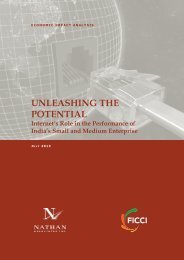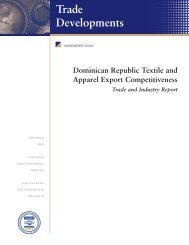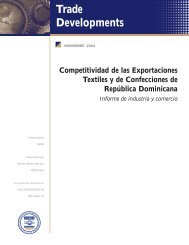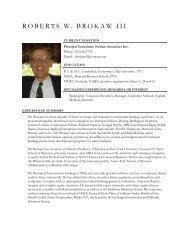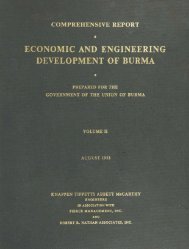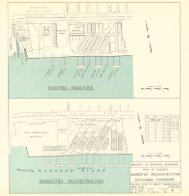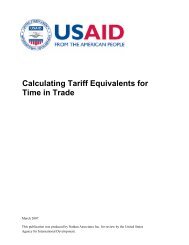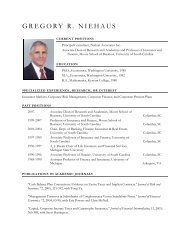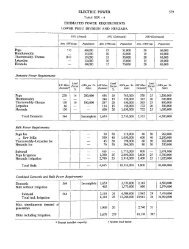Putting it to Work in Developing Countries - Nathan Associates
Putting it to Work in Developing Countries - Nathan Associates
Putting it to Work in Developing Countries - Nathan Associates
Create successful ePaper yourself
Turn your PDF publications into a flip-book with our unique Google optimized e-Paper software.
Table 4-2<br />
Estimated Develop<strong>in</strong>g Country Shares of World Inward FDI S<strong>to</strong>ck, by Sec<strong>to</strong>r, 1990 and 2004<br />
Developed <strong>Countries</strong> Develop<strong>in</strong>g <strong>Countries</strong> Change <strong>in</strong> Develop<strong>in</strong>g<br />
Sec<strong>to</strong>r 1990(%) 2004(%) 1990(%) 2004(%) <strong>Countries</strong>’ Shares<br />
Primary 85.5 60.9 14.5 39.1 24.6<br />
Manufactur<strong>in</strong>g 80.2 79.1 19.8 20.9 1.1<br />
Services 82.5 78.6 17.5 21.4 3.9<br />
Other/Unspecified 70.3 47.6 29.7 52.4 22.7<br />
Total 81.8 77.6 18.2 22.4 4.2<br />
Note: Includes countries classified as “develop<strong>in</strong>g” by UNCTAD. UNCTAD classifies some countries as develop<strong>in</strong>g that<br />
the World Bank considers “high <strong>in</strong>come,” such as S<strong>in</strong>gapore and South Korea, and classifies some as developed that the<br />
World Bank considers “low and middle <strong>in</strong>come,” such as Es<strong>to</strong>nia, the Czech Republic, and Hungary. Data for the countries<br />
<strong>in</strong> UNCTAD’s “South-East Europe and the Commonwealth of Independent States” category are <strong>in</strong>cluded <strong>in</strong> the develop<strong>in</strong>g<br />
country <strong>to</strong>tals for 2004, but data for these countries are not available by sec<strong>to</strong>r and <strong>in</strong>dustry for 1990.<br />
SOURCE: <strong>Nathan</strong> <strong>Associates</strong>, based on UNCTAD, World Investment Report 2006, Annex Table A.1.2.<br />
manufactur<strong>in</strong>g <strong>in</strong>dustries while ga<strong>in</strong><strong>in</strong>g <strong>in</strong> others.<br />
This underl<strong>in</strong>es the fact that develop<strong>in</strong>g<br />
countries do not have an across-the-board compet<strong>it</strong>ive<br />
advantage <strong>in</strong> attract<strong>in</strong>g FDI <strong>to</strong> manufactur<strong>in</strong>g—desp<strong>it</strong>e<br />
their supplies of low-cost labor.<br />
Expand<strong>in</strong>g opportun<strong>it</strong>ies <strong>in</strong> services <strong>in</strong>dustries.<br />
Between 1990 and 2004, the absolute value of<br />
develop<strong>in</strong>g countries’ <strong>in</strong>ward FDI s<strong>to</strong>ck <strong>in</strong> services<br />
skyrocketed by well over 700 percent, from<br />
$152 billion <strong>to</strong> nearly $1.3 trillion. And <strong>in</strong> four<br />
of seven major services <strong>in</strong>dustries that UNC<br />
TAD mon<strong>it</strong>ors, develop<strong>in</strong>g countries have<br />
<strong>in</strong>creased their share of world <strong>in</strong>ward FDI s<strong>to</strong>ck<br />
dur<strong>in</strong>g this period. This means that the rate of<br />
<strong>in</strong>crease <strong>in</strong> FDI flows <strong>to</strong> the develop<strong>in</strong>g world <strong>in</strong><br />
these services has outstripped that of the developed<br />
countries. These ga<strong>in</strong>s <strong>in</strong> share of world<br />
FDI s<strong>to</strong>ck have occurred <strong>in</strong> construction, retail<br />
and wholesale trade, hotels and restaurants, and<br />
especially <strong>in</strong> bus<strong>in</strong>ess services. 2 In some other<br />
<strong>in</strong>dustries, develop<strong>in</strong>g countries <strong>in</strong>creased the<br />
value of their <strong>in</strong>ward FDI s<strong>to</strong>ck, but still lost<br />
shares of world FDI s<strong>to</strong>ck: power, gas and water;<br />
transport, s<strong>to</strong>rage and communications; and<br />
f<strong>in</strong>ance (bank<strong>in</strong>g and <strong>in</strong>surance services). This<br />
suggests that “older” service <strong>in</strong>dustries are more<br />
attractive <strong>in</strong> the developed than <strong>in</strong> the develop<strong>in</strong>g<br />
economies—at least for now, pend<strong>in</strong>g<br />
Ch<strong>in</strong>a’s cont<strong>in</strong>u<strong>in</strong>g liberalization of a broad<br />
range of <strong>in</strong>dustries and markets.<br />
Appeal of Eastern and Central Europe. The<br />
emergence of <strong>in</strong>dustries <strong>in</strong> some former socialist<br />
countries as possible <strong>in</strong>vestment dest<strong>in</strong>ations has<br />
reshuffled global FDI <strong>in</strong>flows somewhat. Recent<br />
data for Eastern and Central Europe show that<br />
these trans<strong>it</strong>ion economies—largely absent from<br />
world FDI flows <strong>in</strong> the pre-1990 socialist era—<br />
have become appeal<strong>in</strong>g dest<strong>in</strong>ations for FDI <strong>in</strong><br />
certa<strong>in</strong> manufactur<strong>in</strong>g <strong>in</strong>dustries. Among these<br />
are food, beverages and <strong>to</strong>bacco; wood and<br />
wood products; chemicals and chemical products;<br />
rubber and plastics; au<strong>to</strong>mobiles and transport<br />
equipment; electronics and electronic<br />
equipment. The power of this appeal is underscored<br />
by a cross-border au<strong>to</strong>motive <strong>in</strong>dustry<br />
cluster that comprises 13 au<strong>to</strong>mobile plants, 10<br />
power tra<strong>in</strong> fac<strong>to</strong>ries, and hundreds of suppliers<br />
<strong>in</strong> a 500-km circle encompass<strong>in</strong>g parts of the<br />
Czech Republic, Hungary, Poland, Slovakia, and<br />
Slovenia. 3 S<strong>in</strong>ce the fall of the Berl<strong>in</strong> Wall, these<br />
trans<strong>it</strong>ion economies have also attracted FDI <strong>in</strong><br />
textiles, cloth<strong>in</strong>g and leather, mach<strong>in</strong>ery and<br />
equipment, and a host of services, <strong>in</strong>clud<strong>in</strong>g<br />
util<strong>it</strong>ies, construction, and transport, s<strong>to</strong>rage,<br />
and communications.<br />
All the shifts <strong>in</strong> the compos<strong>it</strong>ion of FDI s<strong>to</strong>cks<br />
just described may denote “level shifts”—permanent<br />
changes <strong>in</strong> the <strong>in</strong>dustry patterns of FDI<br />
that the develop<strong>in</strong>g world most readily attracts.<br />
What then are the broad implications of these<br />
42



